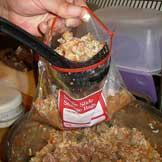
In response to a post about the importance of reading ingredient lists on cat food labels, Westcoastsyrinx said, “Personally I find that the organ meat is not an appropriate regular source of protein as the amino acids are not the same balance as muscle meat, and such parts as kidneys will contain all the toxic residue from the source of the meat.” Westcoastsyrinx makes some important points that I thought were worthy of further discussion.
When you think about it, organ meats, including the kidneys, liver, heart, etc., are a normal part of the feline diet. When cats kill mice or other prey items, they eat most, if not all, of the body, including the internal organs. In fact, many predators show a preference for these parts of the body over skeletal muscle, probably due to the fact that they are excellent sources of protein, vitamins, minerals, and other nutrients.
The following chart compares one ounce (28 g) of raw liver from cattle, raw kidney from cattle, and raw, grass fed beef (Source: nutritiondata.self.com):
As you can see, skeletal muscle is relatively higher in calories and fat per ounce, but is good source of omega-3 fatty acids and calcium. On the other hand, liver excels at providing vitamin A, vitamin K, iron, and phosphorus, and kidneys can provide high levels of vitamin A, vitamin C, vitamin D, calcium, iron, phosphorus, and sodium. My point is not that organ meats are superior to skeletal muscle; simply that they are a natural way to provide cats with many essential nutrients that might otherwise have to be added as supplements to a balanced feline diet.
Westcoastsyrinx is right that organ meats like the liver and kidney can concentrate toxic residues within their tissues because of their role as filters within the body, but when livestock is raised in a healthy manner this does not have to be the case. In my opinion, this is simply an argument in support of buying foods from companies that have a reputation for using wholesome ingredients, not for avoiding organ meats entirely since they can be such good sources of important nutrients for cats.

Dr. Jennifer Coates
Image: Thinkstock









